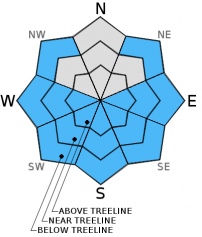| Friday | Friday Night | Saturday | |
|---|---|---|---|
| Weather: | Mostly cloudy to cloudy skies. Isolated snow showers. | Cloudy skies with a chance of snow and rain. | Cloudy skies with snow. |
| Temperatures: | 36 to 43 deg. F. | 24 to 31 deg. F. | 37 to 43 deg. F. |
| Mid Slope Winds: | Southwest | Southwest | Southwest |
| Wind Speed: | 15 to 25 mph with gusts to 35 mph. | 15 to 25 mph with gusts to 40 mph. | 20 to 30 mph with gusts to 50 mph. |
| Expected snowfall: | Trace | Up to 2 | 6 to 12 |
| Friday | Friday Night | Saturday | |
|---|---|---|---|
| Weather: | Mostly cloudy to cloudy skies. Isolated snow showers. | Cloudy skies with a chance of snow. | Cloudy skies with snow. |
| Temperatures: | 35 to 41 deg. F. | 21 to 28 deg. F. | 33 to 39 deg. F. |
| Ridge Top Winds: | Southwest | Southwest | Southwest |
| Wind Speed: | 25 to 35 mph with gusts to 50 mph. | 35 to 40 mph with gusts to 65 mph, increasing to 50 to 55 mph with gusts to 85 mph. | 45 to 55 mph with gusts to 85 mph. |
| Expected snowfall: | Trace | Up to 2 | 6 to 12 |


























